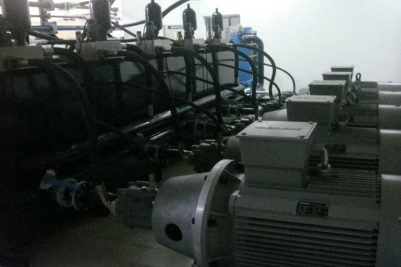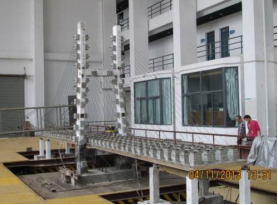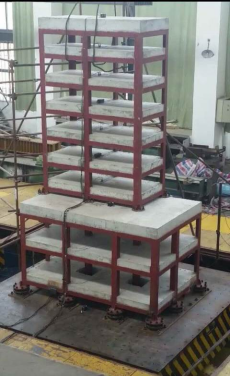1.Application scope
Up to now, there are about 200 sets of shaking table systems for earthquake simulation in the world, which are mostly distributed in America, Japan and China, and most of them are immobile single table.
As any immobile single table has the drawbacks such as single seismic wave action and small test model, the adoption of shaking table array system for studying the seismic performance of large and long-span structures is the trend in the coming days.
This shaking table array system, installed in Fuzhou University and manufactured by Servotest Company, is currently the first such kind of system with mobility in the world, and this is the fourth set. This system can provide a powerful research tool to understand the seismic performance of complicated structures such as railway and roadway bridges, power and communication transmitters, pipelines, high-rise buildings, underground rail systems, vibration test of structural models, and so on.
The general view of this system is shown in Fig.1 and Fig.2.

Fig.1 Triple shaking-table array system for earthquake simulation

Fig.2 The hydraulic pump system
2. System performance
This system is mainly used for all kinds of basic theoretical research in earthquake engineering; for seismic performance research of highroad or railroad as building, long span suspension bridge, cable stayed bridge, viaduct, grade separation bridge, rail train viaduct; for seismic research of city pipeline structure and energy pipeline; for seismic behavior of underground tube structure; for vibration test (input F.G wave, random wave etc.) of the structural models. To provide the test methods for the prototype structures to analysis and study the seismic performance of them.
The system is located on a foundation pit of 10m×30m sizes, and its maximum effective work length is 24m. The system consists of three bi-axial vibration tables--a central immobile table of 4m x 4m (maximum allowable model mass of 22 tons), and two moveable 2.5m x 2.5m tables (maximum allowable model mass of 10 tons) one each side. The work frequency range is 0.1~50Hz with a maximum acceleration of 1.5g when fully loaded. This controlsystem of Pulsar digital program is shown in Fig.3.

Fig.3 Pulsar digital control system
By the way, the digital acquisition system that provided by Jingmin company, Jiangxu province has 128 dynamic channels that can achieve the seismic force, acceleration and velocity, strain, displacement, soilpressure and hydraulic pressure and so on.It is required that the digital acquisition system be fully tuned for various types of signals and also can be updated to 256 channels.
Data acquisition and analysis software can be used and various types of dynamic signal analyzer,such as beused to gain the software control instrument, filtering, parameter setting, and real-time analysis and analysis of signal processing.


Fig 4. Digital acquisition system
3. Typical Testing models
3.1 The testing model of Wuhan Erqi Yangtze River Bridge
The Wuhan Erqi Yangtze River Bridge is a cable stay bridge with three towers and double row cables that located in Hubei province, central China, and its total length and spans plan are 1732m and 90m+160m+616m+616m+160m+90m, respectively. Figure5 is the model of Wuhan Erqi Yangtze River Bridge, which has a scale of 1:100.

Fig.5 Wuhan Erqi Yangtze River Bridge
3.2 The testing model of Wuhan Yingwuzhou Yangtze River Bridge
The Wuhan Yingwuzhou Yangtze River bridge is a suspension bridge with three towers and fours spans, and its total length and spans plan are 2100 and 200m+850m+850m+200m, respectively.
The ratio of rise to span for the main cable is 1/9 and the transverse distance between two main cables is 36m. Figure6 is the model of Wuhan Yingwuzhou Yangtze River Bridge, which has a scale of 1:100.

Fig.6 Wuhan Yingwuzhou Yangtze River Bridge
3.3 The model of a continual two-spans concrete girder bridge
The length of this model bridge is 14.2m, which has two spans, each span is 6.9m and clean span is 6.3m. The girder is hold up by three piers with simple supported, and the piers will be fixed to the platform of shaking tables. The girder and the pier located in the centre large table are hinged, for two small tables the girder can slide freely.
Each pier's mass is about 1.2 tons; the girder's mass is about 7.0 tons, and the quantity of mass steel blocks for compensation (slave mass) have 1500 and all of these are 3.0 tons, so the testing model bridge has a total weight of 13.6 tons.

Fig.7 Continual two-span concrete girder bridge
3.4 The model of a continual two-span T-shape Frame concrete bridge
The model of continual two-span T-shape frame concrete bridge has a length of 12m that the scale of main girder and pier are 1:15 and 1:14.3, respectively. Each span is 6.0m and clean span is 5.8m. The total weight of this model is 144kN that the self-weight is 76kN and the compensatory weight is 32kN.

Fig.8 Continual two span T-shape Frame concrete bridge
3.5 Ganhaizi Bridge in Sichuan
The total length of Ganhaizi Bridge is 1811m. The span arrangements are 40.7m+9×44.5m+ 40.7m for the first joint; 45.1m+3×44.5m+11×62.5m+3×44.5m+45.1m for the second; 45.1m+ 4×44.5m +45.1m for the third. This bridge is located at the earthquake motion transition zone from strong earthquake to weak earthquake, with the peak ground acceleration a=0.362g and corresponding seismic intensity of Ⅷ degrees.


Fig.9 Ganhaizi bridge
Main girder belongs to light-type composite structure, and the tallest pier is over 107m. In order to check out the seismic performance of this new kind of bridge and evaluate the response characteristics during the service stage, it is necessary to carry out the seismic testing using shaking tables. Under the supervision of Professor Bruno Briseghella, the preliminary work including the design of test scheme, manufacturing and assembling of test model and debugging of earthquake simulation shaking table array system, have been finished.


Fig.10 Ganhaizi bridge testing model
3.6A two-span concrete continuous girder bridge with various isolators
The objective using the triple shaking tables of earthquake simulation is toobserve the seismic performance on a two-span concrete continuous girder bridge with various isolators including the general plate rubber bearing, high damping lead rubber bearing and steel composite sliding bearing under the excitation of transverse direction,longitudinal direction as well as bi-direction.
The model of the two-span concrete continuous girder bridge with variousisolators has a scale of 1:5, and the total length is 10.2m with a single clean span of 5.0m that is shown in Fig.11. Its whole weight is about 25.9 tons, where the girder is about 8.6 tons.

Fig.11 two-span concrete continuous girder bridge with various isolators
Theexcitations of seismic waves are El-centro wave,Tar-arzana wave and Northridge wave with PGA of0.096g、0.2g、0.382g, et al, as shown in Fig12. Total testing cases are 66. The results indicate thathigh damping lead rubber bearing and steel composite sliding bearing can reduce the response of girder andpiers effectively.


Fig. 12 Input waves
3.7 Experiment on shaking table array of single tower cable-stayed bridge
The aim of this experiment is to explore thefeatures of the single tower cable - stayed bridge under the lateral, horizontal and two - waye arthquake action by shaking table test, and to study the destruction mode of the single tower cable - stayed bridge under the earthquake action.Themain tower, auxiliary pier and side pierof single tower cable-stayed bridge model was poured with C40 self-compacting concrete,and the total height of the main tower is 4.2m.The main beams and cross beams of the composite beams are made of aluminum alloy plate after bending, and the concrete bridge deck is also simulated with 1.5mm thick aluminum alloy plate. The composite beam is 10m in length. The cable is made of high strength prestressed steel wire with a diameter of 5mm.
The main tower and the main beam is connected by twodouble-sided sliding bearing,andtwo lateral limit device are simulated with rubber sheet; auxiliary pier, side pier and the main beamare connected by the two-way sliding bearing. The main tower, the auxiliary pier, the side pier and the vibration table are bolted,which issimilar tothe rigid foundation. Cable-stayed bridge model is shown in Figure 1. There are four natural seismic waves, which are Chi-chi, El-centro, Cerro Prieto and Lander-amboy, and the acceleration peak increased from 0.05g to 0.4g. The method of the input seismic wave includesunidirectional seismic wave and bidirectional horizontal seismic wave. When the Chi-chi wave reached the peak of 0.4g, the bearing between the composite beam and the side pier is broken. The minor damage occurs, such as Cracks appeared on the anchor head of part of the cable and Structural adhesive cracking, and ultimately stop the test.

Fig.13 Single tower cable - stayed bridge model

Fig.14 Acceleration time history curve


Fig.15 Displacement time history curve
3.8 Experimental study on tower-lines system of ultra-high voltage glass-shaped transmission
Ultra-High Voltage transmission (UHVT) tower-line system is one of the most important infrastructures in our society. It is found that the damage of the UHVT tower-lines system is serious during earth quake according to the investigation on several large earth quakes around the world in recent years. Therefore, it is necessary and meaningful to conduct the seismic research on UHVT tower-line system.

Fig.16 Single transmission tower
This report was based on the background of one million Volt AC UHVT engineering suspension tower of Ximeng - Shandong Project. Shaking table tests of UHVT tower-line system with the geometric similarity ratio of 1:15 scale were carried out analyzing the seismic response of model under seven and eight degrees with basic intensity, frequent intensity as well as rare intensity. The influences of bidirectional excitation's effect and travelling wave effectare analyzed.

Fig.17 Five towers and four lines
3.9 The testing model of a large section tunnel
Jinjishan Tunnel is a Two-tube Highway Tunnel with eight lanes in two directions along Fuzhou 2nd ring road. The inner contour of the tunnel adopts three centre circles; the height is 10.8m; the width is 17.2m. The lining is made of C30 reinforced concrete with a thickness of 70cm; the primary Support of Tunnel use I22 steel arch and C25 shot concrete with a thickness of 30cm. The layers are granite residual salty clay, Sandy soil-completely weathered granite, strongly weathered coarse grained granite from top to bottom.


Acceleration history at spring Acceleration history at vault
Fig.18 El-centro wave
The geometric similarity ratio of model is 1/30, the acceleration similitude ratio is1/1, the modulus of elasticity similitude ratio is1/30 and the whole weight is about 12tons. The earthquake waves of El-centro, CC, Kobe, Taft as well as artificial wave based on the in-site were excited with peak ground acceleration of 0.05g, 0.1g, 0.2g and 0.4g.
From the shack table testing results, we can see that the main damage and cracks are appeared at springs of tunnel.

Fig.19 Shaking table test of tunnel model
3.10 Experimental study on seismic performance of precast segmental concrete double-column piers
The precast segmental construction technology has many features, such as little impact on existing traffic and surrounding environment, high comprehensive economic benefits and short construction period, thus has obvious advantage in the construction of cross-sea and cross-river bridge. The paper reveals the seismic response characteristics failure mechanism and collapse mode of precast segmental double-column piers by the shake table test and finite element analysis. The effects of different design parameters on seismic performance influence rule is studied and provided basis for seismic design and engineering application of precast segmental double-column piers.
The geometric scale ratio of performance of precast segmental concrete double-column pier model is 1:5. The bridge beam size is 3300mm*550mm*350mm, the size of the pile cap is 2400mm*720mm*360mm, the pier height is 1350mm. The effective shear pier span ratio is 5.7,and the diameter of the pier is 250mm. The axial compression ratio of the weight block to the pier column is 5.17%, and the corresponding compressive strain of the concrete is 0.99Mpa.
There are 31 kinds of test cases, seven kinds ofseismic waves and six kinds of natural seismic waves. They are El-Centro (N-S) wave, Northridge wave, Tar-tarzana wave, Wenchuan (N-S) wave, Tangshan (N-S) wave and Chichi (N-S) wave. The other is synthetic wave, named Shanghai wave.

Fig.20 The shaking table test

Fig.21 Shanghai seismic wave


X Y
Fig.22 Displacement time history ofcorrugated pipe connection segmental pier(Shanghai seismic wave)
3.11 Isolation structure under shaking table testfor high-rise vibration
The test purposeunder shakingtable is to verify the shock absorber performance of the vibration isolation structure and tocompare with the numerical model. An eight-story frame structure with typical engineering significance and located in the high intensity region is simplified and scaled to1:7. Thematerials are concrete and steel for columns and girder respectively.
It is2 chassis, X direction is 3 span with length 2.75 m and Y direction is 2 span with length 1.75 m, heightis0.7 m for each floor; The upper tower six floors, X to the two lengths of 2m, and the Y to a single span of 1m, and the height 0.5 m. The floor area ratio of the tower to the chassis is 1:2.4, the tower has a higher width than 1:3, the total height of the model is 4.40 m, the weight of each layer is simplified to the concrete floor slab, and the quality of the structural model is about 16.2 t.
Five series of experimental study on the model, respectively is pure base isolation (isolation rubber bearing), composite isolation 1 reduction (isolation rubber bearing + elastic slide bearing), composite isolation 2 reduction (isolation rubber bearing and viscous dampers), layer spacing (isolation rubber bearing) and the contrast of seismic model.El Centro,Taft,Northridge and artificial waves are input as excitation.



(a)three kind of isolaters

(b)frame structure model
Fig. 23 Shaking table test
3.12 Experimental study on seismic performance of concrete skew bridge
From the 1971 earthquake in San Fernando, the Wenchuan earthquake in 2008 to the 2010 earthquake in Chile, some damages can be seen such as falling beam, excessive lateral displacement or serious damage of pier column and so on. Due to the serious damage of the skewed bridges, the researchers began to study the earthquake damage mechanism, seismic response and seismic design of this kind of bridges after the San Fernando earthquake in 1971. However, the understanding of the seismic damage mechanism is still controversial, the law of seismic response is obviously insufficient, and the lack of effective seismic design concept and construction measures.


Fig.24 Earthquake waves
This project focuses on the seismic response of typical single-span simple and multi-span continuous skewed bridges. A full-bridge test model is designed considering the parameters such as skew angle, span, bridge width, support stiffness, pier stiffness and ground motion input. And a series of simulated seismic shaking table test and numerical simulation analysis are carried out in order to study of seismic damage mechanism of skewed bridges Through the project research, the seismic damage mechanism and the seismic response law of the oblique beam bridge are clarified, and the improved seismic design concept and seismic structure measures are put forward to improve the seismic design of the oblique beam bridge.

Fig.25 Shaking table testing